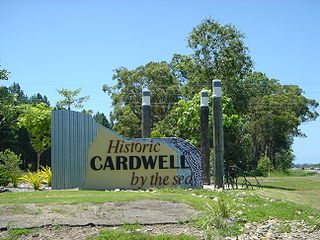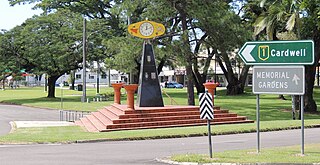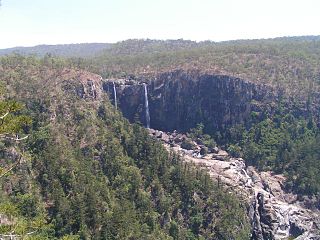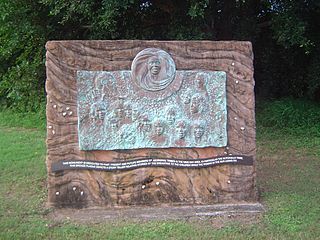The Bakanambia, also known as the Wanbara, are an Aboriginal group of Australia. Traditionally, the Bakanambia lived in the vicinity of Princess Charlotte Bay in the state of Queensland. One of the ethnonyms applied to them was Lama Lama, which is now used of a larger aggregation of remnants of several tribes.

Hinchinbrook Island is an island in the Cassowary Coast Region, Queensland, Australia. It lies east of Cardwell and north of Lucinda, separated from the north-eastern coast of Queensland by the narrow Hinchinbrook Channel. Hinchinbrook Island is part of the Great Barrier Reef Marine Park and wholly protected within the Hinchinbrook Island National Park, except for a small and abandoned resort. It is the largest island on the Great Barrier Reef. It is also the largest island national park in Australia.

Cardwell is a coastal town and rural locality in the Cassowary Coast Region, Queensland, Australia. In the 2016 census the locality of Cardwell had a population of 1,309 people.

Ingham is a town and locality in the Shire of Hinchinbrook, North Queensland, Australia. It is named after William Bairstow Ingham and is the administrative centre for the Shire of Hinchinbrook.

The Herbert River is a river located in Far North Queensland, Australia. The southernmost of Queensland's wet tropics river systems, it was named in 1864 by George Elphinstone Dalrymple explorer, after Robert George Wyndham Herbert, the first Premier of Queensland.
The Manbarra, otherwise known as the Wulgurukaba, are Aboriginal Australian people, and the traditional custodians of the Palm Islands, Magnetic Island, and an area of mainland Queensland to the west of Townsville.
Warrgamay is an extinct Australian Aboriginal language of northeast Queensland. It was closely related to Dyirbal.
The Yidiny, are an Aboriginal Australian people in Far North Queensland. Their language is the Yidiny language.
The Nyawigi people, also spelt Nyawaygi, Nywaigi, or Nawagi, are an Aboriginal Australian people whose original country was around Halifax Bay in Far North Queensland.
The Ngajanji, also written Ngadyan, and Ngadjon-Jii are an Indigenous Australian people of the rainforest region south of Cairns, in northern Queensland. They form one of 8 groups, the others being Yidin, Mamu, Dyirbal, Girramay, Warrgamay, Waruŋu and Mbabaram, of the Dyirbal tribes.

The Butchulla, also written Butchella, Badjala, Badjula, Badjela, Bajellah, Badtjala and Budjilla are an Aboriginal Australian people of Fraser Island, Queensland, and a small area of the nearby mainland of southern Queensland.
The Girramay were an Australian Aboriginal tribe of northern Queensland.
The Wakara or Wakura were an indigenous Australian people of the state of Queensland.
The Madjandji, also known as the Majañji, are indigenous Australian people in the area south of Cairns in the state of Queensland.
The Wanyuru were an indigenous Australian people of the state of Queensland.
The Mingin, also known as the Mingginda, are an Aboriginal Australian people of the state of Queensland, who lived in the Gulf Country east of Moonlight Creek and the Yukulta / Ganggalidda people in the southern Gulf of Carpentaria.
The Biyaygiri, also known as Bandjin, were an Aboriginal Australian people of northern Queensland.
The Kokomini (Gugumini) are reported to have been an indigenous Australian people of the state of Queensland, though some indications suggest the term may refer to a loose confederation of tribal groups.
The Iwaidja are an indigenous Australian people of the Northern Territory.

Hawkins Creek is a rural locality in the Shire of Hinchinbrook, Queensland, Australia. In the 2016 census, Hawkins Creek had a population of 216 people.